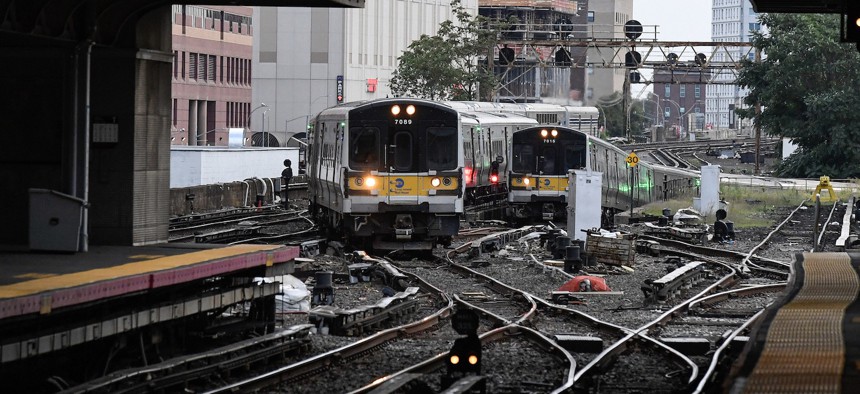Last month, Metropolitan Transportation Authority Chairman and CEO Pat Foye warned in an emergency board meeting that ridership and tax revenue shortfalls have pushed the authority into a serious financial crisis. Nearly $4 billion in emergency aid from the federal government has now been exhausted, and the MTA forecasts a deficit of $3.2 billion for the rest of the year.
After imploring the United States Senate to give more emergency funding, Foye outlined a series of drastic measures that he warned the MTA might be forced to take. Subways and buses within New York City could see significant cuts to service frequency: the time between subway trains would increase by eight minutes and between buses by up to 15 minutes. These alterations, Foye claimed, would save $880 million per year, once losses from reduced ridership are factored in. The Long Island Rail Road and Metro-North suburban commuter train systems, for their part, might see service cut by half for $160 million in annual savings. Even these and other cost savings, however, wouldn't be enough for the MTA to survive without federal help.
These dire threats come largely from the MTA's refusal to take a look at its own operations. AsI andothers have pointed out for years, MTA operations are riddled with massive overspending and wastes of labor: a slate of operational reforms and modernization could have reduced operational expenditures enough to cover the entire current deficit.
Operating budget bloats are by far the worst on the Long Island Railroad. Patrick O'Hara, long-time author of a newsletter reporting on the LIRR's operations and finances,points out that the LIRR could save $1 billion per year in operating costs without harming service. The biggest line item: conductors, whose main job is simply to check passengers' tickets. In 2016, the LIRR spent $257 million in total compensation on 1,397 conductors, or about $184,000 each—a very large expense for a job requiring little skill. Conductors on commuter trains are rare outside the United States: on most European rail systems, a smaller crew of roving fare inspectors conducts random ticket inspections. O'Hara estimates that this reform alone could save more than $240 million per year on the LIRR alone—50% more than the MTA estimates could be saved by drastic service cuts on both commuter railroads. The LIRR could save even more money by other reforms such as such as improving maintenance and labor productivity -- which are low even compared to Metro-North, thanks to steam-era work rules that, among other things, guarantee train drivers doubled pay for every day they have to work on both a diesel train and an electric train. Another possible reform, O'Hara claims: reforming overtime payments to prevent senior employees from running up overtime in their last years of service, in order to inflate their pension payments.
Within New York City Transit as well, there's a vast amount of operational waste. The New York City subway isstill one of the few in the world to run trains with both a driver and conductor on board: experiments several years ago to run some lines with only one employee were ended due to opposition and lawsuits from the Transit Workers' Union. Compensation for conductors now costs about $300 million per year.
A vastly greater expense is found in subway track maintenance, which is extraordinarily inefficient even by American standards. Per track mile, the New York City subway spends four times the amount of money on track and facilities maintenance as any other subway system in the United States besides PATH. Reducing maintenance expenditures just to the level of the most expensive American system outside New York would save $1.4 billion every year. The causes of NYCT's expensive track maintenance are difficult to know, as the MTA makes very little information on its maintenance practices public. But to judge from the scanty information that I have gleaned from MTA workers, it seems likely that much of New York's problem lies in overstaffing for roles such as “flaggers”--workers who stand at the edges of worksites to signal passing trains to slow down, but who don't do any maintenance work themselves.
True, some ways of reducing operational costs could not be implemented overnight: some stations, for example, would have to be equipped with closed-circuit cameras to allow drivers to close doors. Proof-of-payment systems may require buying some additional, though relatively inexpensive, ticket vending machines. The MTA’s labor unions have long opposed modernization steps that would eliminate jobs, even during periods of low unemployment.
But some operational cost reductions, at any rate, could be implemented quickly: the L and 7 subway lines, for example, are already equipped for operation with one staffer per train. And operational improvements would ultimately put the MTA on a better footing than undiscriminating service cuts, which—if they cause a greater decline in ridership than predicted—might require further service cuts in a self-reinforcing ridership death spiral. Foye's threatened service cuts would hardly spare workers, either: they would entail the permanent reduction of 8,000 staff.
It's hard to avoid a suspicion that MTA leadership is attempting what some sardonic political observers have called the “Washington Monument strategy”: implement budget cuts in ways as visible to the public as possible to create political pressure for more funding. But in any case, no one should believe that drastic service cuts are the MTA's only option for dealing with budget shortfalls. And for its part, the federal government should earmark a portion of any aid to the MTA for capital spending to improve operational efficiency, and should condition any aid package on a credible commitment to reforms.
NEXT STORY: A Carbon Free New York?


